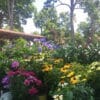
Image from Home Outside: Creating the Landscape You Love, due for release in January, 2009, by Taunton Press. Photo by Randy O’Rourke.
I invariably ask guests at dinner parties −around dessert time- to tell me about the trysting places of their lives. Some are confused- what is a trysting place? Once I define my terms, however, everyone has something to say.
The word “tryst”- derived from the Scandinavian for “watch post”- is an agreement (as between lovers) to meet. So a trysting place is a place of assignation for romantic activities; somewhere to go to get away from the world in order to contemplate one’s soul mate, and through him or her, one’s own soul.
So what do my guests describe? They tell of coming upon mossy glades and perching at pondsides. Of nestling in pine-needled bowers and nuzzling within abandoned boxcars on a remote railroad siding. One young man recalled mounting his college’s stone tower with a lover; another remembered hunkering down under an overturned canoe on a beach along a remote river way up in Maine. Adolescent fantasies; adult desires; romances on the land.
Courtship Patterns
When I think carefully about it, I find that courtship tends to follow a particular path–a journey through time and space that, with a clear sense of design, can help you create a landscape that mirrors one’s sense of a penultimate tryst in the form of a garden.
What does the traditional Meeting of the Eyes- a moment of electrical attraction and visual connection between two individuals- look like as a part of a garden? In diagrammatic terms, it suggests a meeting point that widens where two opposing paths come together—an expanded gateway, perhaps deep enough to be nearly gazebo-like, with opposing benches and framed in climbing vines in flower. From this point, a new direction is suggested; one whose design can be very different in character, depending upon the trysters themselves. The Meeting of the Eyes is the gateway into the garden of Love.
The next part of this romantic garden journey might be called the “Meeting of the Hearts”—a phase in which longing kicks in and one’s imagination runs wild. This is a long phase in a courtship, a path that winds and dips; stops and starts; parts and comes together. It can be a short, intense path that goes straight ahead to a destination, or long and circuitous, a set of trails that come together and move apart in an almost dance-like set of patterns, as with the parterre-like forms of the Minuet.
Next is the “Meeting of the Bodies”—the most physical and palpable part of this courtship ritual, where ecstasy is the goal and for which a stopping place is necessary in a garden. The destination point can be any of the trysting places already described, or any new ones that you can think up. I once saw a flower show exhibit called the “Garden of Dreams” in which a moss bed, complete with sphagnum pillow and twiggy bed frame was featured–not a bad place to experience the delights of the Other!
If not a place to lie, or a bower in which to nestle, shouldn’t a place designed for two actual bodies to come together feature one or a set of focal points that symbolize the act that takes place within its confines? What do the focal points look like of a place where bodies are meant to meet? For the Meeting of the Bodies is the literal and figurative climax of a garden experience, and this pinnacle encounter can be registered from the male point of view or the female, depending upon the designer and his or her orientation. Obviously, a garden with a pool filled with upward-spouting fountains suggests a different climactic experience than one whose focal point is a pool with softly bubbling waters, or better yet, one whose bubbler moves water down and inward, rather than out and upward. And, the real trick of all is to have these two symbolic experiences happen simultaneously—If you combine a quietly flowing spring with an upward-pluming spray jet you recreate in three-dimensional form the climactic pleasures of physical union.
Finally, after numerous trysts and meetings between the two Bodies comes the “Meeting of the Souls”—where physical satiety is complete and spiritual union sets in; where garden paths are designed for a twosome to stroll arm-in-arm and to meander aimlessly from one beautiful place to another. This is a time of bodily enervation combined with contemplative awareness—a king of beautiful lassitude that comes from straining the limits of one’s physical energy, and, in the process, freeing one’s mind to relax its usual vigilance towards the world. With this kind of sexual enlightenment, when accompanied by reverence and love, comes a concurrent merging of two souls, as a kind of mutual mini-enlightenment, bigger than both together.
At the end of the garden path lies one final element—the “Return to Real Life” where longing and memory become fused and the emotional becomes real. This may be a return to the original threshold through which you entered the garden, or better yet, a quiet back exit—as at a Japanese Love Hotel—seen by no one except one’s lover, so that the tryst remains a secret to the outside world. The simplest garden path, imbued with the meaning and magic of a significant tryst, becomes an icon; an image that is resurrected twenty years later at dinner parties such as mine, when the mind’s eye recalls in exquisite detail the meanders and moods of a lover’s stroll through a garden forever captured and transformed.







I found your site on technorati and read a few of your other posts. Keep up the good work. I just added your RSS feed to my Google News Reader. Looking forward to reading more from you down the road!
Your blog is interesting!
Keep up the good work!